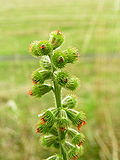Note: This is a project under development. The articles on this wiki are just being initiated and broadly incomplete. You can Help creating new pages.
Difference between revisions of "Thymus vulgaris - Thyme"
(→Uses) |
(→Parts Used) |
||
| Line 7: | Line 7: | ||
==Parts Used== | ==Parts Used== | ||
| − | {{Parts Used| | + | {{Parts Used|Flowers}}, {{Parts Used|Leaves}}. |
==Chemical Composition== | ==Chemical Composition== | ||
Revision as of 16:41, 11 June 2018
Thyme is an evergreen herb with culinary, medicinal, and ornamental uses. The most common variety is Thymus vulgaris. Thyme is of the genus Thymus of the mint family (Lamiaceae), and a relative of the oregano genus Origanum.
Contents
[hide]- 1 Uses
- 2 Parts Used
- 3 Chemical Composition
- 4 Common names
- 5 Properties
- 6 Habit
- 7 Identification
- 8 List of Ayurvedic medicine in which the herb is used
- 9 Where to get the saplings
- 10 Mode of Propagation
- 11 How to plant/cultivate
- 12 Commonly seen growing in areas
- 13 Photo Gallery
- 14 References
- 15 External Links
Uses
Digestive disorders, fevers, Snakebites, depression, respiratory tract infections, skin and scalp complaint, tonsillitis, tonsillitis, Sore throats, whooping cough, bronchial catarrh, laryngitis.
Parts Used
Chemical Composition
The essential oil was isolated in a yield of 1.25% by steam distillation from the aerial part of the plant and subsequently analyzed by GC-MS. The major components were p-cymene (8.41%), γ-terpinene (30.90%) and thymol (47.59%).[1]
Common names
| Language | Common name |
|---|---|
| Kannada | |
| Hindi | Jangli ajwain |
| Malayalam | |
| Tamil | |
| Telugu | |
| Marathi | NA |
| Gujarathi | NA |
| Punjabi | NA |
| Kashmiri | NA |
| Sanskrit | |
| English | Himalayan Thyme, Wild Thyme |
Properties
Reference: Dravya - Substance, Rasa - Taste, Guna - Qualities, Veerya - Potency, Vipaka - Post-digesion effect, Karma - Pharmacological activity, Prabhava - Therepeutics.
Dravya
Rasa
Tikta (Bitter), Kashaya (Astringent)
Guna
Laghu (Light), Ruksha (Dry), Tikshna (Sharp)
Veerya
Ushna (Hot)
Vipaka
Katu (Pungent)
Karma
Kapha, Vata
Prabhava
Habit
Identification
Leaf
| Kind | Shape | Feature |
|---|---|---|
| Simple | The leaves are divided into 3-6 toothed leaflets, with smaller leaflets in between |
Flower
| Type | Size | Color and composition | Stamen | More information |
|---|---|---|---|---|
| Unisexual | 2-4cm long | Yellow | 5-20 | Flowers Season is June - August |
Fruit
| Type | Size | Mass | Appearance | Seeds | More information |
|---|---|---|---|---|---|
| 7–10 mm (0.28–0.4 in.) long pome | clearly grooved lengthwise, Lowest hooked hairs aligned towards crown | With hooked hairs | {{{6}}} |
Other features
List of Ayurvedic medicine in which the herb is used
- Vishatinduka Taila as root juice extract
Where to get the saplings
Mode of Propagation
How to plant/cultivate
Sow about the middle of March or early April, in dry, mild weather, moderately thin, in shallow drills about 1/2 inch deep, and 8 or 9 inches apart, in good, light soil, in a warm position.[3]
Commonly seen growing in areas
Dry slopes, rocks and maquis, limestone soils.
Photo Gallery
References
External Links
- Pages with broken file links
- Ayurvedic Herbs known to be helpful to treat Digestive disorders
- Ayurvedic Herbs known to be helpful to treat fevers
- Ayurvedic Herbs known to be helpful to treat Snakebites
- Ayurvedic Herbs known to be helpful to treat depression
- Ayurvedic Herbs known to be helpful to treat respiratory tract infections
- Ayurvedic Herbs known to be helpful to treat skin and scalp complaint
- Ayurvedic Herbs known to be helpful to treat tonsillitis
- Ayurvedic Herbs known to be helpful to treat Sore throats
- Ayurvedic Herbs known to be helpful to treat whooping cough
- Ayurvedic Herbs known to be helpful to treat bronchial catarrh
- Ayurvedic Herbs known to be helpful to treat laryngitis
- Herbs with Flowers used in medicine
- Herbs with Leaves used in medicine
- Herbs with common name in Hindi
- Herbs with common name in English
- Habit - Evergreen herb
- Index of Plants which can be propagated by Seeds
- Index of Plants which can be propagated by Cuttings
- Herbs that are commonly seen in the region of Dry slopes, rocks and maquis
- Herbs that are commonly seen in the region of limestone soils
- Herbs


